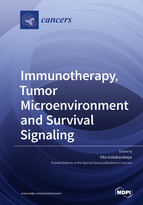Immunotherapy, Tumor Microenvironment and Survival Signaling
A special issue of Cancers (ISSN 2072-6694). This special issue belongs to the section "Cancer Immunology and Immunotherapy".
Deadline for manuscript submissions: closed (30 October 2020) | Viewed by 106764
Special Issue Editor
2. Department of Medicine, University of Oklahoma, Oklahoma City, OK 73126, USA
Interests: Immunotherapy; CAR-T cells; tumor microenvironment; checkpoint protein; hypoxia; tumor survival signaling
Special Issues, Collections and Topics in MDPI journals
Special Issue Information
Dear colleagues,
Immunotherapies have recently shown remarkable results in the treatment of cancer patients. However, there are still many questions that remain to be solved for more effective therapies, such as tumor heterogeneous profile, tumor microenvironment, and tumor survival epigenetic and genetic pathways, all of which make patients resistant to the presently available treatments for cancer.
This issue will focus on different immunotherapies, CAR-T, CAR/NK autologous and allogeneic therapies, and tumor microenvironments such as checkpoint proteins, hypoxia, tumor surrounding cells macrophages, cancer-associated fibroblasts, vascular and angiogenic pathways, cytokines, chemokines, T reg cells blocking immune response, and tumor intracellular pathways contributing to resistance to immunotherapies. This issue will highlight different combination therapy and next-generation personalized therapy approaches that will be developed in the future to enhance patient treatment.
Dr. Vita Golubovskaya
Guest Editor
Manuscript Submission Information
Manuscripts should be submitted online at www.mdpi.com by registering and logging in to this website. Once you are registered, click here to go to the submission form. Manuscripts can be submitted until the deadline. All submissions that pass pre-check are peer-reviewed. Accepted papers will be published continuously in the journal (as soon as accepted) and will be listed together on the special issue website. Research articles, review articles as well as short communications are invited. For planned papers, a title and short abstract (about 100 words) can be sent to the Editorial Office for announcement on this website.
Submitted manuscripts should not have been published previously, nor be under consideration for publication elsewhere (except conference proceedings papers). All manuscripts are thoroughly refereed through a single-blind peer-review process. A guide for authors and other relevant information for submission of manuscripts is available on the Instructions for Authors page. Cancers is an international peer-reviewed open access semimonthly journal published by MDPI.
Please visit the Instructions for Authors page before submitting a manuscript. The Article Processing Charge (APC) for publication in this open access journal is 2900 CHF (Swiss Francs). Submitted papers should be well formatted and use good English. Authors may use MDPI's English editing service prior to publication or during author revisions.
Keywords
- Checkpoint protein
- CAR-T therapy
- Tumor microenvironment
- Survival
- Hypoxia







